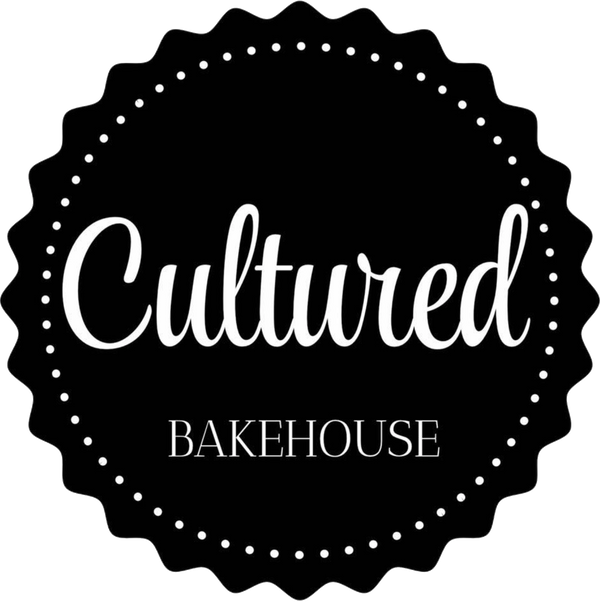Baking is a beautiful mix of science, creativity, and, let’s be honest—sometimes pure chaos. But when you’re baking for people with food sensitivities or allergies, it becomes a whole new level of responsibility. I get it. That’s why I’m here to walk you through the basics of allergen-free baking, so you can create incredible treats that everyone can enjoy.
This isn’t about complicated techniques or fancy equipment—this is real-life baking, the kind I do every day at Cultured Bakehouse. And yes, everything here is free from the 14 most common allergens (because we want everyone at the table).
1. Mise en Place: The Secret to Stress-Free Baking
Let me tell you—this little French term, mise en place (meaning “everything in its place”), has saved me more times than I can count. Before you even preheat that oven:
• Gather all your ingredients. And I mean all of them. Double-check for sneaky allergens. For example, oats? Make sure they’re certified gluten-free. Some brands aren’t as careful as they should be.
• Measure everything ahead of time. Baking is a science, and precision matters. Use proper measuring cups and spoons, especially for dry and liquid ingredients.
• Prep your equipment. Line trays with parchment paper, grease pans, and make sure your mixing bowls are spotless—especially if you’re avoiding cross-contamination.
Tip: Set up a “baking zone” if you’re making allergen-free recipes in a shared kitchen.
Even a stray crumb can cause issues for someone with severe allergies.
2. Allergen-Free Ingredient Swaps That Actually Work
Finding substitutes that behave like their allergen-filled counterparts is tricky, but oh-so-rewarding when you get it right.
Flour Alternatives (Gluten-Free & Fabulous)
I know, gluten-free flours can be finicky, but with the right combos, they’re magic.
• All-Purpose Gluten-Free Flour: A good 1:1 blend (some have xanthan gum, I normally use one without it and add it if needed) is a solid starting point.
• Chickpea Flour: Adds protein and a slightly nutty taste—amazing in savory bakes.
• Coconut Flour: Super absorbent. You’ll need more liquid than usual.
• Tapioca or Arrowroot Starch: Perfect for giving baked goods that chewy texture.
Pro tip: Mix flours for the best results. I love combining coconut flour with tapioca to balance absorbency and softness.
Dairy-Free Swaps
Plant-based milks are everywhere now, but not all are created equal when it comes to baking.
• Oat Milk – My go-to for creamy bakes. It behaves a lot like dairy milk.
• Rice Milk – Light and slightly sweet. Great for cakes.
• Coconut Milk – Adds a lovely richness but can dominate flavors—use wisely.
For butter replacements:
• Coconut Oil – Fantastic for cookies and cakes.
• Vegan Butter – Use it 1:1 for butter in most recipes. Look for brands labeled allergen-free.
Egg Alternatives That Actually Work
Eggs are a tough one, but I’ve cracked it (pun intended).
• Flax Egg: Mix 1 tbsp flaxseed meal with 3 tbsp water. Let it sit until it’s gooey—voilà! One egg replacement.
• Mashed Bananas or Applesauce: Ideal for moist bakes like muffins or brownies.
• Commercial Egg Replacers: Great for more structured bakes, like cookies or pancakes.
3. Mixing Techniques That Make or Break Your Bake
Even with perfect ingredients, mixing matters.
• Creaming Method: Beat your sugar and fat (like coconut oil or vegan butter) until fluffy. This adds air and helps your bakes rise.
• Folding: Be gentle! Use a spatula to fold wet and dry ingredients together—especially with delicate batters like gluten-free cakes.
• Don’t Overmix: Overworking the dough leads to dense bakes, especially in gluten-free recipes. Stir until just combined.
4. Temperature Tricks for Consistent Results
• Room Temp Matters: Your plant-based milk, egg replacers, and even butter alternatives should be room temperature before mixing. It helps them blend better.
• Oven Thermometers Are Your Best Friend: Trust me—oven dials lie. Stick a thermometer inside and bake at the actual right temperature.
• Preheat. Always. Especially with allergen-free baking, timing and temperature are crucial for rise and texture.
5. How to Tell When It’s Done (Without Guessing)
Doneness can be tricky with allergen-free recipes, but these tips never fail me:
• Cakes – Gently press the center; it should spring back. A toothpick should come out clean or with a few moist crumbs.
• Cookies – Look for golden edges. They’ll continue cooking on the tray after you pull them out.
• Breads – Tap the bottom; it should sound hollow if baked through.
And yes, resist the urge to open the oven door 100 times. It messes with the baking temp!
6. Cooling, Storing & Keeping It Fresh
• Cool Completely: Gluten-free and dairy-free bakes can crumble if you cut into them too soon. Let them cool fully on a wire rack.
• Storage Tips: Use airtight containers and separate allergen-free bakes from others if you’re in a shared household.
Want to freeze them? Most gluten-free baked goods freeze beautifully. Just wrap them tightly first or slice depending on food.
7. Final Thoughts: Don’t Fear the Flop
Allergen-free baking isn’t always perfect the first time—and that’s okay. Some of my best recipes came from trial and error. Keep a little notebook for tweaks and substitutions, and don’t be afraid to get creative.
And remember: baking is meant to be fun. The best bakes happen when you’re relaxed, experimenting, and (of course) taste-testing along the way.
If you try any of these techniques or have your own tips, tag me on Instagram (@culturedbakehouse)—I love seeing your creations!
Happy Baking! 💛
Zilka
Royal Free Picture by Elina Fairytale. Please follow her at: https://www.instagram.com/elina_sazonova

